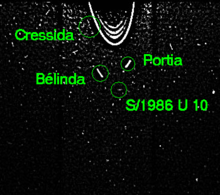Cressida (moon)
| Cressida | |
|---|---|
| Voyager 2 shot of Cressida, Portia and Ophelia | |
| Provisional or systematic name | S / 1986 U 3 |
| Central body | Uranus |
| Properties of the orbit | |
| Major semi-axis | (61,766.73 ± 0.05) km |
| Periapsis | 61,744 km |
| Apoapsis | 61,789 km |
| eccentricity | (0.00036 ± 0.00011) |
| Orbit inclination | 0.006 ± 0.040 (equatorial plane) ° |
| Orbital time | 0.463569601 ± 13 · 10 −9 d |
| Mean orbital velocity | 9.6896 km / s |
| Physical Properties | |
| Albedo | (0.08 ± 0.01) |
| Apparent brightness | (21.58 ± 0.11) mag |
| Medium diameter | 79.6 ± 4 (92 × 74 × 74) km |
| Dimensions | ≈ 3.4320 · 10 17 kg |
| surface | ~ 20,000 km 2 |
| Medium density | ≈ 1.3 g / cm 3 |
| Acceleration of gravity on the surface | ≈ 0.013 m / s 2 |
| Escape speed | ≈ 34.0 m / s |
| Surface temperature | ≈ −184 to −209 ° C / 64–89 K |
| discovery | |
| Explorer | |
| Date of discovery | January 9, 1986 |
| Remarks | Physical data relatively imprecise. |
Cressida (also Uranus IX ) is the fourth innermost and one of the smaller of the 27 known moons of the planet Uranus .
Discovery and naming
Cressida was discovered on January 9, 1986 by the astronomer Stephen P. Synnott on photographs taken by the Voyager 2 space probe . The discovery was announced on January 16, 1986 by the International Astronomical Union (IAU); the moon was initially given the provisional designation S / 1986 U 3 .
Cressida is a tragic heroine from William Shakespeare's tragedy Troilus and Cressida . She is the daughter of the Trojan priest Kalchas , who switched to the side of the Greeks because he foresaw the fall of Troy. Cressida has to switch to the Greeks through Kalchas in exchange for the Trojan army leader Antenor and, contrary to her previous expressions of love, is unfaithful to Troilus, which leaves him deeply hurt.
Cressida also appears in stories by Geoffrey Chaucer and others.
All the moons of Uranus are named after characters from Shakespeare or Alexander Pope . The first four Uranus moons discovered ( Oberon , Titania , Ariel , Umbriel ) were named after suggestions by John Herschel , the son of the Uranus discoverer Wilhelm Herschel . Later the tradition of naming was retained.
Track properties
Orbit
Cressida orbits Uranus on a prograde , almost perfectly circular orbit at an average distance of around 61,767 km (approx. 2.417 Uranus radii) from its center, i.e. 36,208 km above its cloud ceiling. The orbit eccentricity is 0.00036, the orbit is inclined 0.006 ° to the equator of Uranus .
Cressida is the second innermost moon in the Portia group , which also includes Bianca , Desdemona , Juliet , Portia , Rosalind , Cupid , Belinda and Perdita . These moons have similar orbits and similar spectral properties.
The orbit of the next inner moon Bianca is on average 2,601 km away from Cressida's orbit, that of the next outer moon Desdemona is only 892 km.
Cressida is located in the middle of two Uranus rings, the inner ε (epsilon) ring , which is on average around 10,618 km from the Cressida orbit, and the inner edge of the outer ν (Ny) dust ring at 4,333 km away.
Cressida orbits Uranus in 11 hours, 7 minutes and 32.41 seconds. Since this is faster than the rotation of Uranus, Cressida rises in the west and sets in the east as seen from Uranus.
It moves within a critical distance, near the Roche limit , in a descending orbit around the planet and will at some point be torn apart as a result of tidal forces into a ring or fall or burn up in Uranus' atmosphere.
rotation
It is believed that Cressida rotates synchronously and that its axis has an incline of 0 °.
Physical Properties
Cressida has a mean diameter of 79.6 km. In the images taken by the Voyager 2 spacecraft , Cressida appeared as an elongated object measuring 92 × 74 × 74 km, with the long axis aligned with Uranus.
Its mean density of 1.3 g / cm 3 is significantly lower than the density of the earth and indicates that the moon is mainly composed of water ice .
It has a very low albedo of 0.08; That is, 8% of the incident sunlight is reflected from the surface. It is therefore a very dark celestial body.
The acceleration due to gravity on its surface is 0.013 m / s 2 , which corresponds to about 1 ‰ of that on earth.
The mean surface temperature of Cressida is estimated to be between −184 ° C and −209 ° C (89–64 K ).
In the spectrum , the surface of Cressida appears gray.
Otherwise, not much is known about this moon, as the probe images were taken at a great distance and therefore have a low resolution.
It is possible that Cressida will collide with Desdemona, almost 900 km away, within the next 100 million years .
exploration
Since Voyager 2's flyby, the Uranus system has been studied extensively by both Earth-based observations and the Hubble Space Telescope . The orbit parameters of Cressida could be specified more precisely.
Web links
- IAUC 4164: Satellites of Uranus January 16, 1986 (discovery)
- IAUC 4165: Satellites of Uranus January 17, 1986 (Correction to IAUC 4164)
- IAUC 4609: Satellites of Saturn and Uranus June 8, 1988 (numbering and naming)
- Polish moon page: Cressida description and further links (English)
- Satellite Viewer Orbit simulation of the Uranus moons


